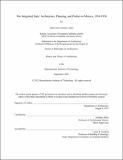The Integrated State: Architecture, Planning, and Politics in Mexico, 1938-1958
Author(s)
López, Albert José-Antonio
DownloadThesis PDF (249.3Mb)
Advisor
Dutta, Arindam
Terms of use
Metadata
Show full item recordAbstract
This dissertation focuses on the intersections of the professionalization of architecture, regional and national infrastructure planning, and Mexican politics during the first three decades following the Mexican Revolution. I especially aim to shed light on the political and managerial role of architects during a crucial period of pseudo state-corporatism, dominant party political "institutionalization," and ideologically fraught nationalist socio-economic development occurring between the late 1930s to mid1950s.
I argue that architects became central figures in mid-century Mexican political society and the state's planning bureaucracy as Mexico's mode of governmentality shifted from an ideologically flexible post-conflict reconstructionist model to various modalities of governance ranging from socialist and nationalist interpretations of pseudo state-corporatism, increasing executive branch empowerment with varied levels of presidentialism, and eventually the embrace of a developmentalist, technocratic and bureaucratic authoritarianism.
An important faction of Mexican Architects argued their indispensability to political society and appealed to popular support via print journalism, but also public speeches, and use of other mass forms of media, in a broad and long-term collective mobility project. The key claim of this faction – and in particular the small handful of its most capable and already politically connected leaders – was that the architectural profession possessed not only artistic and creative defining qualities, but also technical and managerial capabilities that could serve the very particular constructive needs of post-revolutionary nation-state construction and socio-economic development. They additionally sought to differentiate their training, especially in regards to their expertise on urbanism, town and regional planning, and graphic projection in general so as to distinguish themselves from other technical professions, such as engineering, as they competed for primacy in the growing bureaucracies that held jurisdiction over the infrastructural organization of the national territory. However, some of the deepest inroads by architects into Mexican political society were made by those who proved to be equally capable in using the written and spoken word so as to characterize themselves as public intellectuals, visionaries, and moral reformers. These were powerful figures in the construction of a modern public and political consciousness at a time when Mexico was undergoing internal crisis and transformation due to outcries against corruption, uncertain developmentalist success, changing political dispensations, and the framing of new legitimizing, regenerative, and nationalist modernizing programs.
Date issued
2021-09Department
Massachusetts Institute of Technology. Department of ArchitecturePublisher
Massachusetts Institute of Technology